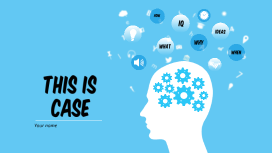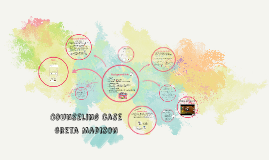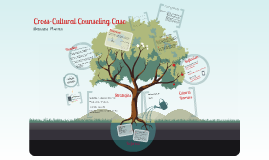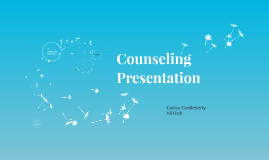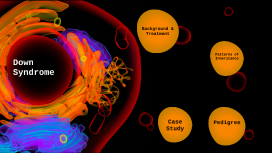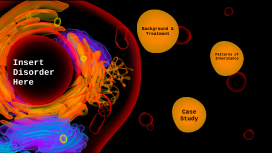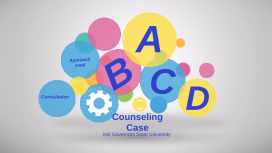Counseling case
Transcript: Often took turn twice, out-of-order Crying, whining, laughing in peers faces, pointing, leaving game social story Evidence-based! When it is my friend’s turn, I will try to wait patiently. When I wait patiently, I watch my friends take their turns. I might encourage them by saying “Good job!” or “Way to go!” Power Cards Teacher reports difficulty taking turns, regulating emotions after winning/losing game Interfering with socialization in classroom Peers refusing to play with him Front Back Goal 1 Goals Session 6: Recap Diverse needs does not equal one-size-fits all I cannot always be first when I play with friends. My friends like to have their turns be first too. When I play with friends, I might say “I was first last time. Now you can be first.” Friends are happy when I play fair and let them be first too. When playing a game with peers, Chris will take a turn twice and/or take a turn out-of-order. Session 2: How we take turns Baseline = Never responds appropriately (0%) When my friends are done with their turn, I take my turn fairly. I only take one turn. When my turn is done, I let my friends take their turn. Some progress! Most strides seen when prompted to refer to power card and/or behavioral chart Can connect taking-turns, being a good player to being a good friend Teacher reports slight progress at Week 3 Teacher Interview Have a good break!! Current progress & Next steps Power Card Strategy involves including special interests with visual aids to teach and reinforce academic, behavioral and social skills to individuals with Autism Spectrum Disorders. Evidence-based for students with ASD Counseling case Greta Madison Session 1: Building rapport Behaviors Background Info Session 4: Power cards, how to be a good winner, social skills=friends coping strategies When my turn is over, I will try not to pout, whine or cry. That is not using good manners. It's polite to take turns. When I take turns, I am using good manners. Friends like when I use good manners. When playing a game with peers, Chris will respond inappropriately to winning or losing. individualized curriculum whining, crying, leaving the game, laughing in a peers face, jumping up and down, pointing and/or saying “HA HA”. 1. Direct instruction of social skills 2. social story 3. psycho-education 4. relaxation techniques 5. power cards Coping Strategies improving social skills, enhancing perspective-taking, increasing self-monitoring Counseling Model Taking Turns CBT Adaptions Agendas First experience working with a student with ASD! Goal 3 Emotional Regulation Last Session Tomorrow GAS completed by teacher Coping strategy "quiz" Classroom observation "Chris" 10 year old, 4th grader Currently in self-contained classroom Diagnosis of ASD Also very low cognitive and academic Counseling minutes on his IEP Supportive family Low attention span, active, limited social skills, eye contact, etc. “The use of CBT techniques in a school setting for children with ASD is a natural pairing given the social nature of the school setting; there is a benefit of having the immediate availability for participants to practice their skills in a natural laboratory” (Mennuti et al., 2012). Goal 2 Baseline- Takes appropriate turns approx. 25% of time ("Rarely") Session 5: Practice skills with peers .... Also come to the School Psychers End-of-Quarter Social tonight after class at Rhein House!! Taking turns Operational Definition After 6 weeks of attending weekly counseling sessions, Chris will respond appropriately to winning and losing. When friends are together, they take turns. Feelings Felix is a star baseball player for the Seattle Mariners. He must patiently wait his turn to go to bat. Felix likes to win, but sometimes he loses. When he wins, he smiles and says “alright!” When he loses, he takes a deep breath and says “good job” to his opponent or “maybe next time.” My thoughts... Games should be fun for everyone! If you win a game, you can “smile” and say “alright!” If you lose, you can take a deep breath, say “good job” to your opponent or “maybe next time.” Play games the Felix way and your friends will have fun playing with you. Classroom observation After 6 weeks of attending weekly sessions, Chris will take appropriate turns when playing games with peers (initiating a turn, taking only one turn, waiting for next turn, relinquishing turn when necessary). My friends will be happy when I use good manners and take turns. They will want to play with me again. Session 3: Coping strategies to deal with frustration cognitive behavior therapy (CBT) When playing a game with peers, Chris is unable to identify coping strategies to deal with his emotions. Because of limited attention and engagement, I had to supplement CBT with behavioral interventions. Baseline- Can't identify any reasons he should take turns After 6 weeks of attending weekly counseling sessions, Chris will be able to identify at least one reason why he should take turns when playing with peers.







